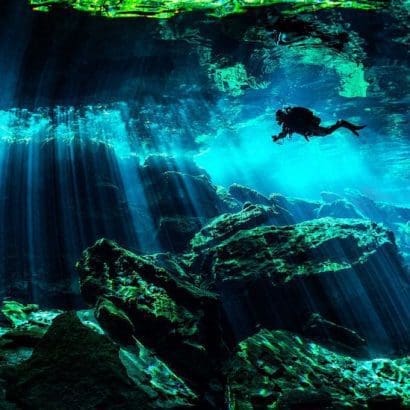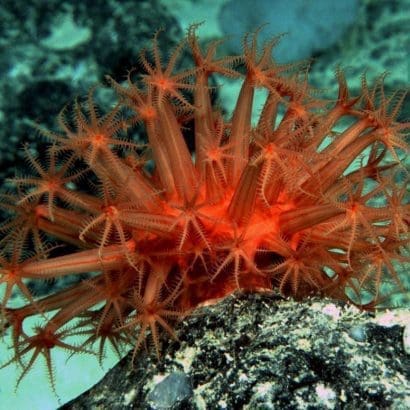
Whales, majestic giants of the ocean, have captured the imagination of humans for centuries. As awe-inspiring marine mammals, they reign over the vast seas with their immense size and remarkable adaptations. From the enchanting songs of humpback whales to the breathtaking acrobatics of orcas, these magnificent creatures continue to fascinate both scientists and nature enthusiasts alike.
In this article, we delve into the world of whales, exploring their origins, diverse species, extraordinary adaptations, migratory behaviors, and crucial ecological roles. Join us on this journey as we uncover the wonders of these colossal beings and understand the significance of preserving their existence for the health of our marine ecosystems.
Contents
Origin and Evolution.🐟
Whales, these magnificent giants of the ocean, have a fascinating evolutionary history that spans millions of years. From their humble terrestrial origins to their complete adaptation to an aquatic lifestyle, their journey is a testament to the wonders of evolution and adaptation.
Evolutionary History: From Land to Sea.
The story of whales’ evolution begins on land, with their ancestors believed to be small, four-legged mammals that roamed the Earth over 50 million years ago. These early relatives of whales gradually found their way to the water, likely seeking food or escaping predators. Through a series of evolutionary changes, they developed characteristics that would eventually turn them into fully aquatic creatures.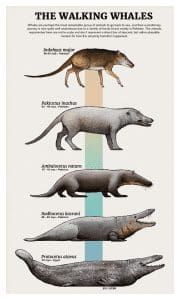
Over time, these land-dwelling ancestors underwent various transformative stages. One significant milestone was the development of streamlined bodies and limb modifications, transforming their limbs into flippers that aided in swimming. These adaptations were crucial for their survival in the water and enabled them to move with greater efficiency.
Major Theories on Whales’ Unique Adaptations for Marine Life.
The evolution of whales from land to sea has been a subject of scientific interest and debate. Several theories attempt to explain how these creatures developed their distinctive features to thrive in the marine environment:
- The Convergence Theory: This theory suggests that different groups of ancient mammals independently transitioned to an aquatic lifestyle. Each group evolved similar adaptations in response to the challenges and opportunities of living in the water. This could explain why different species of whales share certain characteristics despite not sharing a recent common ancestor.
- The Descent with Modification Theory: Also known as the “phylogenetic gradualism” theory, this idea proposes that whales’ aquatic adaptations gradually evolved from a common terrestrial ancestor. Over time, certain traits were favored through natural selection, resulting in the emergence of fully aquatic species we see today.
- The Hydrodynamic Efficiency Hypothesis: According to this theory, the primary driving force behind whales’ adaptations was the need to increase their hydrodynamic efficiency for efficient swimming and diving. This led to the development of streamlined bodies, reduced limbs, and specialized structures such as flukes for powerful propulsion.
Species Diversity.🐟
Whales exhibit a remarkable diversity, comprising various species that inhabit oceans worldwide. From the awe-inspiring blue whale to the acrobatic humpback whale and the enigmatic gray whale, these marine mammals captivate us with their unique traits and widespread presence across the globe.
Presentation of Different Whale Species.
The world of whales is a rich tapestry of diverse species, each with its own distinct characteristics and behaviors. Among the most renowned whale species are:
Blue Whale (Balaenoptera musculus):
The blue whale holds the title of being the largest animal ever known to have existed on Earth. With lengths reaching up to 100 feet and weighing over 200 tons, these gentle giants roam the world’s oceans, feeding primarily on krill. Their impressive size and majestic appearance make them an iconic symbol of marine biodiversity.
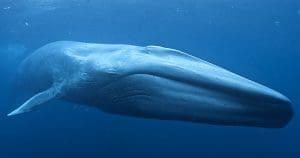
Humpback Whale (Megaptera novaeangliae):
Known for their acrobatic displays, humpback whales are famous for their breaching behavior, where they leap out of the water and crash back down with a spectacular splash. These whales are also celebrated for their complex songs, which vary among different populations. Their migratory routes cover vast distances as they move between feeding and breeding grounds.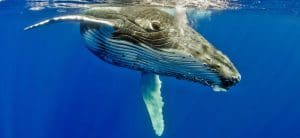
Gray Whale (Eschrichtius robustus):
The gray whale undertakes one of the longest migrations of any mammal, traveling thousands of miles between its feeding grounds in the Arctic and its breeding lagoons in Baja California, Mexico. These whales are known for their friendly and curious behavior towards humans, making them a popular attraction for whale watchers.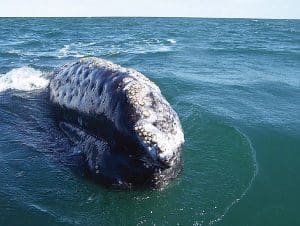
Distinctive Characteristics and Geographic Distribution of Each Species
Each whale species possesses unique features that distinguish them from one another:
- The blue whale has a sleek, bluish-gray body with mottled patches, and its immense size and broad, flat rostrum are key characteristics. They can be found in all major oceans, though their populations are most abundant in high-latitude areas where krill concentrations are highest.
- The humpback whale is easily recognizable by its long pectoral fins, knobbly head, and ventral grooves that expand during feeding. They are widespread across the world’s oceans, with different populations inhabiting both polar and tropical waters.
- The gray whale has a distinctive mottled gray appearance, and its most notable feature is the presence of “whale lice,” small crustaceans that attach to its skin. They are primarily found along the eastern North Pacific coast, with their migration route taking them between the Arctic and Mexico.
Behavior and Migrations.🐟
Whales are not only fascinating for their sheer size and physical adaptations but also for their complex social behaviors and remarkable migratory patterns. These marine mammals exhibit a diverse range of behaviors, often displaying a strong sense of community and communication within their respective species.
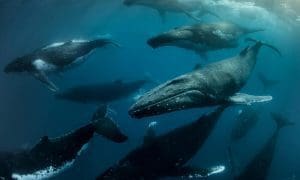
Social Behavior of Whales: Formation of Groups and Communication
Whales are known for their highly social nature, forming tight-knit groups that vary depending on the species. Some common types of social groupings include:
- Pods: Pods are the most common social structure among whales and are typically composed of several individuals from the same species, including family members. These close-knit groups engage in activities such as feeding, traveling, and even playing together.
- Maternal Groups: Female whales often form maternal groups, where mothers and their calves stay together for an extended period. These groups allow for the sharing of knowledge and protection against potential threats.
- Bachelors’ Groups: In certain species, young male whales form bachelor groups, where they interact and socialize without the responsibilities of breeding or protecting a territory.
Impressive Whale Migrations: Patterns and Reasons Behind their Movements
Whale migrations are among the most remarkable journeys in the animal kingdom. These migrations are often driven by seasonal changes in food availability and breeding opportunities. Some key points about whale migrations include:
- Feeding Migrations: Many whale species undertake extensive migrations in search of abundant food sources. For instance, blue whales travel from polar regions to more temperate waters where krill, their primary food source, is plentiful during certain times of the year.
- Breeding Migrations: Some whale species undertake migrations to reach specific breeding grounds where they give birth and care for their calves. Gray whales, for example, undertake one of the longest annual migrations, traveling from their feeding grounds in the Arctic to the warm waters of Baja California, Mexico, to give birth.
- Navigational Abilities: Whales exhibit remarkable navigational skills during their migrations. They rely on various cues, such as Earth’s magnetic field, ocean currents, and celestial navigation, to navigate vast distances accurately.
- Cultural Transmission: Some whale populations pass down migration routes and behaviors from one generation to another, indicating a form of cultural transmission within the species.
Ecological Importance.🐟
Whales play a crucial role in the marine ecosystem, contributing significantly to the balance and health of our oceans. Their impact extends beyond their awe-inspiring size and beauty, as they fulfill vital ecological functions that benefit both marine life and the planet as a whole.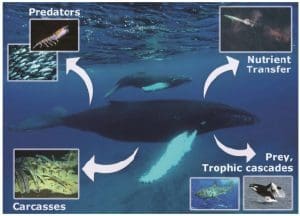
Fundamental Role of Whales in the Marine Ecosystem: Regulation of Phytoplankton and Climate Change Mitigation
Whales play a critical role in maintaining the delicate balance of the marine food web. Some key ecological contributions include:
- Regulation of Phytoplankton: Phytoplankton, microscopic algae that float near the ocean’s surface, are responsible for a significant portion of Earth’s oxygen production through photosynthesis. Whales contribute to the regulation of phytoplankton populations by consuming large quantities of krill and other zooplankton. This, in turn, prevents the overgrazing of phytoplankton, allowing these essential microorganisms to thrive and continue producing oxygen.
- Carbon Sequestration and Climate Change Mitigation: Whales play an essential role in mitigating climate change by sequestering carbon. When whales die, their bodies sink to the ocean floor, carrying with them vast amounts of carbon from their accumulated biomass. This process, known as “whale fall,” helps remove carbon from the atmosphere and store it in the deep ocean, contributing to the planet’s carbon balance.
Impact of Whaling and Pollution on Whale Populations and the Environment
Despite their ecological significance, whales have faced severe challenges due to human activities:
- Whaling Impact: Historically, commercial whaling severely depleted whale populations, leading to the near extinction of several species. Though whaling has significantly decreased due to international conservation efforts, some whale populations are still recovering from the damage done in the past.
- Contamination and Pollution: Whales are vulnerable to environmental pollution, especially through the accumulation of toxins in their bodies. Pollutants like heavy metals, PCBs, and plastics can be ingested by whales, leading to various health issues and affecting their reproductive success.
- Ecosystem Disruption: The decline of whale populations can have cascading effects on the entire marine ecosystem. As apex predators, whales help control the abundance of prey species, preventing overpopulation and promoting ecosystem stability. Their absence can disrupt the balance of marine food webs and lead to unintended consequences for other marine species.
Conservation and Protection.🐟
The conservation and protection of whales and their habitats have become imperative in the face of increasing human impacts on the marine environment. Recognizing the ecological importance of whales and the significance of preserving their populations, various global initiatives and scientific research efforts are dedicated to safeguarding these magnificent creatures for future generations.
Initiatives and Global Efforts to Protect Whales and their Habitat
Numerous international organizations and agreements work towards the conservation and protection of whales. Some key initiatives include:
- International Whaling Commission (IWC): The IWC is an intergovernmental organization focused on the conservation of whales and the management of whaling practices. It has implemented measures to protect endangered whale species, establish sanctuaries, and promote sustainable whaling practices for specific populations.
- Convention on International Trade in Endangered Species of Wild Fauna and Flora (CITES): CITES regulates the international trade of endangered species, including certain whale species, by imposing restrictions and regulations to prevent illegal trade and ensure their protection.
- Marine Protected Areas (MPAs): Governments and conservation organizations establish MPAs to safeguard critical habitats for marine species, including whales. These protected areas offer safe havens for feeding, breeding, and migration, reducing human impacts and enhancing conservation efforts.
- Whale Watching Regulations: Many countries have implemented guidelines and regulations for responsible whale watching to minimize disturbances to whales and their natural behaviors. This promotes ecotourism while protecting the welfare of these gentle giants.
Scientific Research and Technologies for Monitoring and Tracking Whale Populations
Scientific research is fundamental to understanding the behavior, migration patterns, and population dynamics of whales. Several methods and technologies are utilized to study and monitor these magnificent creatures:
- Acoustic Monitoring: Researchers use underwater hydrophones to record whale vocalizations and songs, allowing them to identify species, study communication patterns, and estimate population sizes.
- Satellite Tracking: Satellite telemetry allows scientists to track the movements of tagged whales in real-time, providing valuable data on migration routes, feeding areas, and seasonal behaviors.
- Photographic Identification: Photo-identification involves capturing images of individual whales’ flukes or dorsal fins, which have unique patterns. By comparing these images over time, scientists can track individual whales, monitor their health, and estimate population sizes.
- DNA Analysis: Genetic studies help determine genetic diversity and relationships among whale populations, providing insights into their breeding patterns and migratory connections.

